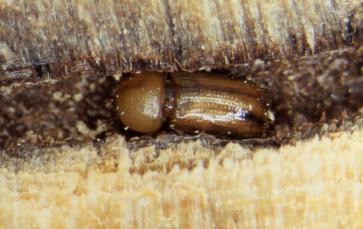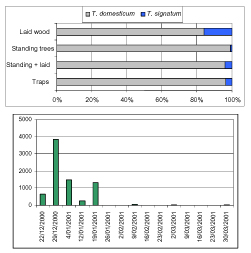Context
In the autumn of 1999, foresters in the Ardennes region of southern Belgium noticed an unusual problem affecting the beech woods: a number of trunks had a sizeable lesion at the base of the crown on the north side, in most cases colonised by wood-destroying fungi and wood-eating insects.The origin of this disease remains uncertain. However, the extent of the problem, its simultaneous occurence over a huge geographical area and the topographical distribution, indicating that altitude and exposure to northerly winds were determining factors, suggest that it was due to an unusual climatic event during the winter of 1998-1999. A thorough examination of the lesions, calluses and annual rings provide additional clues in support of this hypothesis (Huart & Rondeux, 2001).
Until the spring of 2001, despite the impressive volume of wood involved (250,000 m³ over 38,000 hectares), the occurrence of wood-eating insects in still living but extensively cankered trees was hardly surprising, especially since only the cankered areas and their edges were colonised by the insects. Except for the worst affected sites, where the felling of the many affected trees in itself compromised the stability of the stands, the fate of the healthy trees gave no cause for concern.
However, in March 2001, massive attacks of Trypodendron domesticum and Trypodendron signatum occurred at the base of the trunks, in apparently healthy parts of the trees, and also on a great number of trees with no necrosis which until then had characterised the timber colonised by these beetles. This surprising development, bordering on an epidemic, very quickly changed the outlook, as it suddenly appeared that Trypodendron, hitherto regarded as a purely secondary pest, could at times of heavy infestation move into living trees that showed no signs of weakness. Doubts thus arose as to the likelihood of survival of the trees under attack and also, therefore, the secondary importance of the bark beetles involved. At any rate the beetles had shown the amount of economic damage they can do to a forest. Even assuming only the weakened trees to be colonised by these insects, the resulting loss of commercial value is considerable.
In view of the extent of the damage and the unknowns, the Walloon regional authorities decided to fund several research teams with complementary expertise: forest management and economics, entomology and phytopathology. A crisis unit was then set up.
Objectives
AimsThe aims of the entomological side of the research are as follows:
1)Identifying the species concerned
Various species of scolytid can be trapped in large numbers in the affected beech forests without this indicating any connection with the “beech tree disease” ravaging the Ardennes. Tests have been organised to identify the species involved in the phenomenon under investigation and to assess its relative significance.
2)Primary/secondary status of Trypodendrons
One aspect of the research is directed at verifying the “secondary pest” status of Trypodendrons, now called into question by these unprecedented attacks on living trees.
3)Biology of wood-eating scolytidae
In order to control bark beetle infestation and limit its effects, a number of little-known aspects of the biology of Trypodendrons and Xyleborus dispar are being investigated: flight periods, multiplication rate, dispersion capacity, wintering conditions and sites and aggregative behaviour.
4)Trapping
Attractants and trapping devices
Pheromones from related species and other attractants are being tested, on their own or in conjunction, in order to develop the most efficient trapping technique possible. Bark traps and various types of trap are also being tried out to the same end. The latter aspect is accompanied by a study of bark beetle behaviour on approaching the traps.
Measuring the impact on populations
The impact of trapping on populations in situ is measured to determine the effectiveness and expediency of possible species-specific trapping exercises.
5)Measuring and monitoring scolytid populations
Accurate measurement of populations of potentially harmful scolytid species would enable foresters to take appropriate measures as soon as levels established as critical are reached. The design of such measures is the focus of specific research with a view to ultimately developing a monitoring network.
Results obtained
Analysis of wood-boring beetle gallery distribution in several stands and the trapping data have identified T. domesticum as by far the most prevalent species and the most likely to settle in living beech trees.Contrary to previous assumptions, this univoltine species mainly overwinters in the wood and starts to emerge in February, whereas T. signatum generally emerges in summer and therefore winters in various hideaways apart from its natal galleries. Its spring flights are later than those of T. domesticum.
Analysis of the distribution of attacks and sequential felling trials have not shown any indication of these insects being primary pests. A tree is not attacked when newly felled, but only becomes vulnerable after a few weeks.
Lineatine, a pheromone used in trapping T. lineatum, a wood-boring beetle specific to conifers, proved very attractive to Trypodendrons in the deciduous forests. Moreover, a remarkable synergistic effect was observed for lineatine in combination with ethanol.
Deployment of IPM traps at a rate of four per hectare in a stand with a moderate level of beech tree disease (around 20% of the trees attacked) showed that three times as many Trypodendrons could be caught as settled in the trees. These results demonstrate the effectiveness of trapping, but not its expediency. The point is that in the absence of a climatic event to make the trees attractive, the Trypodendrons, even in large numbers, do no damage. Furthermore, when large populations are present, so many insects escape the traps that trapping does not seem to be a suitable means of lessening the damage. It therefore appears crucial to have a means of detecting climatic or other incidents likely to trigger such a crisis. Moreover, measurement of population levels and year-to-year monitoring ought to allow unusually high levels to be detected and appropriate measures to be proposed to forest managers.
This last point is the subject of co-ordinated studies with researchers in neighbouring regions of France, Germany and the Grand Duchy of Luxembourg.
Partners
The entomological side of this research project is being carried out jointly with the Animal and Cell Biology Laboratory (Professor J.-C. Grégoire) at Brussels Free University.The forest management and economic aspects are being investigated by O. Huart and J. Rondeux (Gembloux Agricultural University).
Mycological aspects are the responsibility of F.X. Carlier and H. Maraîte (Louvain Catholic University).
Funding
- DGARNE


